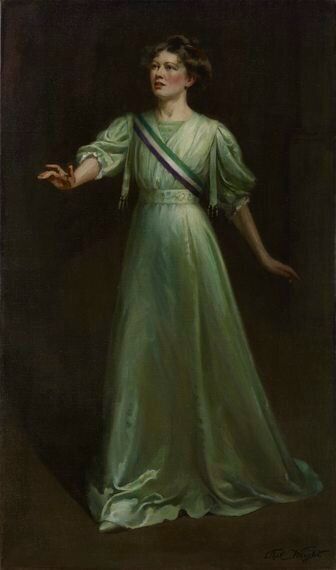

A portrait of Christabel Pankhurst has gone on public display for the first time in 80 years at the National Portrait Gallery.
Alongside the portrait is a display of photographs and archive material of suffragettes, their protests and the headlines they created marking 100 years since the campaigners staged their final and most violent protests, including an attack on National Portrait Gallery paintings, just before the outbreak of the First World War.
Christabel Pankhurst, Emmeline's eldest and most favoured daughter, was central to the Women's Social and Political Union (WSPU), the official name of the suffragettes (the term 'suffragettes' was actually a derogatory term coined by the Daily Mail which Emmeline took up as a badge of honour).
Christabel was instrumental in planning not just the protests but the social and cultural programme for votes for women, including editing the journal The Suffragette.
In the portrait by Ethel Wright, Christabel is in a flowing green dress and wearing a sash comprised of the three colours adopted as a uniform by the WSPU - purple for dignity, white for purity and green for hope.
The portrait was first displayed at the Women's Exhibition which was staged in London, in 1909. Since then it has only been seen at two small exhibitions in the early 1930s, organised by suffrage societies. The portrait was purchased by prominent suffragette Una Dugdale Duval in 1909, and has remained with the family until this bequest to the National Portrait Gallery.
The display supporting this painting is Suffragettes: Deeds Not Words, which explores the events that took place during the final months of the campaign for female suffrage before the outbreak of the First World War.
In these years suffragette action had escalated to civil disobedience and serious vandalism, including arson and bombing, to get their voices heard.
Included in the display are a number of iconic images from the protests, including the funeral cortege for Emily Davison, the suffragette who died in a protest at Epsom Derby. Her funeral was an extraordinary occasion. Thousands of suffragettes accompanied the coffin, most of whom in the WSPU uniform of white, purple and green.
There is also the famous image of an emaciated Emmeline Pankhurst, weak from repeated hunger strikes in Holloway prison, being lifted up and removed from a protest outside Buckingham Palace.
Additionally there are some surveillance photos of some of the suffragettes. As the suffragette protests increased in violence and disruption, the police took undercover photos of the leading ladies in the protests and distributed these to public places such as galleries and shops.
I had seen many of these images before in a more significant display of surveillance of the suffragettes at the Museum of London. However what this display brings is its unique focus on how this fed into art galleries in particular.
In 1913, Mary Richardson famously took a meat clever to Velazquez's Rokeby Venus in the National Gallery. In this display, the National Portrait Gallery shares confidential communication they received from the police at the time, warning them of possible similar attacks that could happen to them.
In fact these warnings became reality when Anne Hunt entered the National Portrait Gallery with a butcher's cleaver and slashed the portrait of gallery founder Thomas Carlyle, in protest at Emmeline Pankhurst being rearrested.
These documents are fascinating, the highlight of the display. The suffragettes were very much seen, by the police, as the terrorists of their day, in a way that seems perverse and bizarre to us now. It's also a reminder to women on just how violent the fight was - and how resistant the Establishment was - to obtain the vote.
There's also the extraordinary written confirmation that women are not allowed to enter galleries unless chaperoned by a man who could vouch for their behaviour.
Given that this painting and display have been promoted together, it's a little strange that the two are not shown together. Instead the painting of Christabel is opposite a painting of her mother in Room 30, whilst the display of suffragette photos and headlines is in a glass cabinet in Room 31.
Nevertheless, so long as you don't forget one when visiting the other, these present a great opportunity to really see the impact that the suffragettes had on society.
National Portrait Gallery, London to May 10, 2015
Admission Free
Image credits:
1. Dame Christabel Pankhurst by Ethel Wright, exhibited 1909 © National Portrait Gallery, London
2. Emmeline Pankhurst's arrest at Buckingham Palace by an unknown photographer, 21 May 1914 © National Portrait Gallery, London
3. Surveillance Photographs of Militant Suffragettes by Criminal Record Office, 1914 ©National Portrait Gallery, London